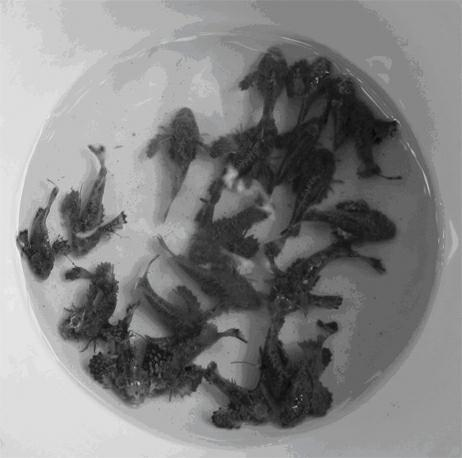Cage culturing method of inimicus japonicus
A technology for cage culture and ghost scorpionfish, which is applied in fish farming, application, climate change adaptation, etc., to achieve the effect of simple and easy-to-learn operation methods and high economic value.
- Summary
- Abstract
- Description
- Claims
- Application Information
AI Technical Summary
Problems solved by technology
Method used
Image
Examples
Embodiment 1
[0038] A method for cultivating scorpionfish in cages, comprising:
[0039] (A) Cultivation of scorpionfish fingerlings: select artificially bred scorpionfish fry, use live mysis shrimp as bait in net cages in sea areas, and then domesticate the bait, and cultivate them into scorpionfish fingerlings for breeding;
[0040] (B) Cultivation and management of scorpion scorpionfish: Breed scorpion scorpionfish fingerlings into net cages in sea areas by feeding chilled miscellaneous fish and shrimp bait to breed scorpion scorpionfish commercial fish.
[0041] The body length of the scorpionfish fry in the step (A) is 2.0-2.4cm, and the feeding amount of the scorpionfish fry is 8000 fish / box.
[0042] The specifications of the sea area cages used in the step (A) are 2-4m×2-4m×3-5m (depth), and the mesh of the cages is 0.3-0.5cm.
[0043] The feeding amount of live mysis in the step (A) is 4-6 kg each time, and feeding is once every 3 days.
[0044] The bait domestication in the ste...
Embodiment 2
[0050]The seawater conditions in the steps (A) and (B) are water temperature 28.6°C, salinity 29.5, pH value 8.12, dissolved oxygen 5.40mg / L, ammonia nitrogen content 0.053 mg / L, flow velocity 0.1~0.2m / s, The stocking quantity of scorpionfish fry is 12,000 / box, and the stocking quantity of scorpionfish fingerlings is 5,000 / box.
[0051] The parts not mentioned above are the same as the specific embodiments.
Embodiment 3
[0053] The seawater conditions in the steps (A) and (B) are water temperature 21°C, salinity 28, pH value 7.91-8.12, dissolved oxygen 7.5 mg / L, ammonia nitrogen content 0.042 mg / L, flow rate 0.1-0.2m / s, the feeding amount of scorpionfish fry is 10,000 / box, and the feeding amount of scorpionfish fingerlings is 4,000 / box.
[0054] The parts not mentioned above are the same as the specific embodiments.
[0055] The above descriptions are only preferred embodiments of the present invention, and all equivalent changes and modifications made according to the scope of the patent application of the present invention shall fall within the scope of the present invention.
PUM
| Property | Measurement | Unit |
|---|---|---|
| Body length | aaaaa | aaaaa |
Abstract
Description
Claims
Application Information
 Login to View More
Login to View More - R&D
- Intellectual Property
- Life Sciences
- Materials
- Tech Scout
- Unparalleled Data Quality
- Higher Quality Content
- 60% Fewer Hallucinations
Browse by: Latest US Patents, China's latest patents, Technical Efficacy Thesaurus, Application Domain, Technology Topic, Popular Technical Reports.
© 2025 PatSnap. All rights reserved.Legal|Privacy policy|Modern Slavery Act Transparency Statement|Sitemap|About US| Contact US: help@patsnap.com



